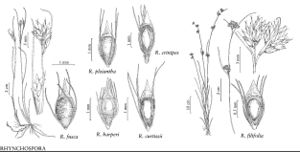Rhynchospora fusca
in W. Aiton and W. T. Aiton, Hortus Kew. 1: 127. 1810.
Plants perennial, cespitose, 10–50 cm; rhizomes stoloniferous, slender. Culms erect to excurved, filiform, leafy, ± terete. Leaves shorter than culm; blades ascending, filiform, proximally to 1.5 (–2) mm wide, apex trigonous, tapering, setaceous. Inflorescences: lateral spikelet clusters (0–) 1–2, distant, terminal cluster ellipsoid to broadly turbinate or hemispheric, branches ascending; leafy bracts setaceous, overtopping clusters. Spikelets redbrown to deep brown, lanceoloid, (4–) 5–6 (–7) mm, apex acute; fertile scales lanceolate, 4–5 (–6) mm, apex acuminate, midrib often excurrent as awn. Flowers: bristles 5–6, longest reaching at least past tubercle base, mostly to tip or beyond, antrorsely barbellate. Fruits 2 (–3) per spikelet, (2.3–) 2.5–2.6 (–3) mm with pedicellar joint, receptacle, and tubercle; body lustrous, pale-brown to deep brown, obovoid to ellipsoid, lenticular, 1–1.5 × 1 mm, margins narrow, flowing to tubercle; surfaces longitudinally finely lined, transversely very finely ridged with wavy rows of very narrow, vertical lattices, sometimes also with lines of shallow pits; tubercle triangularsubulate, (0.7–) 1–1.3 (–1.5) mm, base lunate, margins setulose proximally.
Phenology: Fruiting summer–fall.
Habitat: Sands and peats of pond shores, bogs, and seeps
Elevation: 0–400 m
Distribution

N.B., Nfld. and Labr., N.S., Ont., Que., Sask., Conn., Del., Ill., Ind., Maine, Md., Mass., Mich., Minn., N.H., N.J., N.Y., Pa., R.I., Vt., Wis., Europe
Discussion
Selected References
None.
Lower Taxa
"shortened" is not a number."wider" is not a number.
